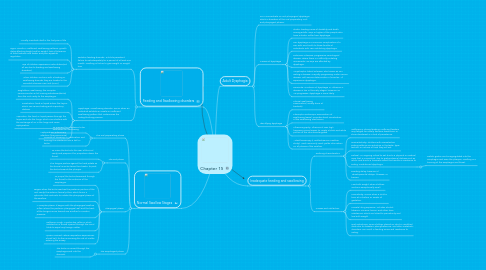
1. Feeding and Swallowing disorders
1.1. Pediatric feeding disorder: a child's persistent failure to eat adequately for a period of at least one month, resulting in failure to gain weight or weight loss.
1.1.1. Usually manifests itself in the first year of life
1.1.2. Signs: unsafe or inefficient swallowing patterns, growth delay affecting height and/or weight, lack of tolerance of food textures and tastes, and poor appetite regulation.
1.1.3. 10% of children experience malnutrition(not all are due to feeding and swallowing disorders)
1.1.4. When children are born with a feeding or swallowing disorder they are treated in the neonatal intensive care unit (NICU).
1.2. Dysphagia: a swallowing disorder, occurs when an individual exhibits an unsafe or inefficient swallowing pattern that undermines the eating/drinking process.
1.2.1. Deglutition: swallowing, the complex neuromuscular act of moving substances(bolus) from the oral cavity to the esophagus.
1.2.2. Penetration: food or liquid enters the larynx, which can cause choking and respiratory distress.
1.2.3. Aspiration: the food or liquid passes through the larynx and into the lungs, which can interfere with the exchange of air in the lungs and cause asphyxiation.
1.2.4. Asphyxiation: pulmonary infection (like pneumonia)
2. Normal Swallow Stages
2.1. The oral preparatory phase
2.1.1. To prepare the substance to be swallowed for swallowing.
2.1.2. Consists of chewing, or mastication and forming the substance into a ball or bolus.
2.2. The oral phase
2.2.1. To move the bolus to the rear of the oral cavity and prepare it for propulsion down the throat.
2.2.2. The tongue pushes against the hard palate as the buccal muscles tense the cheeks, to push the bolus towards the pharynx.
2.3. Pharyngeal phase
2.3.1. To propel the bolus downward through the throat to the entrance of the esophagus.
2.3.2. Begins when the bolus reaches the posterior portion of the oral cavity, the anterior faucial pillars, which forms a sphincter that contracts to initiate the pharyngeal phase of the swallow.
2.3.3. A complex phase, it begins with the pharyngeal swallow reflex, where the posterior pharyngeal wall and the back of the tongue move toward one another to create a pressure.
2.3.4. Reflexive cough: a protective reflex in which exhaled air is forced upward through the vocal folds to expel any foreign matter.
2.3.5. Apneic moment: where respiration experiences a brief halt, further minimizing the risk of matter entering the airway.
2.4. The esophageal phase
2.4.1. The bolus is moved through the esophagus and into the stomach.
3. Inadequate feeding and swallowing
3.1. Defining characteristics
3.1.1. Inefficiency: during feeding, inefficient feeders may fatigue too easily, become breathless, or show disinterest or a lack of persistence.
3.1.2. Overselectivity: children with overselective eating patterns are restrictive in the taste, type, texture, or volume of food they will eat.
3.1.3. Refusal: An ongoing refusal to eat due to a physical or medical issue that is unresolved, due to gastrointesinal distress such as refulx, and due to a traumatic event that results in resistance to eating, conditioned dysphagia.
3.1.3.1. Refulx: gastric acid is regurgitated into the esophagus and even the pharynx, resulting in a burning of the esophagus and throat.
3.1.4. Feeding delay: because of developmental delays, illnesses, or trauma.
3.2. Causes and risk factors
3.2.1. Low birth weight: when children are born exceptionally small.
3.2.2. Prematurity: occurs when a child is born at or before 37 weeks of gestation.
3.2.3. Prenatal drug exposure: includes alcohol, tobacco, cocaine, heroin, and other toxic substances, which are linked to prematurity and low birth weight.
3.2.4. Diet restrictions: some children placed on strict or modified diets due to diabetes, phenylketonuria, and other metabolic disorders, can result in feeding issues and resistance to eating.
4. Adult Dysphagia
4.1. SLP's concentrate on oral-pharyngeal dysphagia which is disorders of the oral preparatory, oral, and pharyngeal phases.
4.2. Causes of dysphagia
4.2.1. Stroke: leading cause of disability and death among adults. 50% or higher of the people who have a stroke, suffer from dysphagia.
4.2.2. TBI: dysphagia is a common complication of a TBI, with one-fourth to three-fourths of individuals with TBI's exhibiting dysphagia.
4.2.3. Parkinson's disease: progressive neurological disease, where there is a difficulty initiating movements. 50-92% are affected by dysphagia.
4.2.4. Amyotrophic lateral sclerosis: also known as Lou Gehrig's disease, a rapidly progressing motor neuron disease, with severe deterioration of muscles. All experience dysphagia.
4.2.5. Dementia: Incidence of dysphagia in Alzheimer's disease is low in the early stages, however, as AD progresses, dysphagia is more likely.
4.3. Identifying dysphagia
4.3.1. Clinical swallowing examination( usually done at bedside)
4.3.2. Fiberoptic endoscopic examination of swallowing (FEES): provides direct visualization of the swallowing mechanism.
4.3.3. Ultrasonography: ultrasound, uses high frequency sound waves to create a black-and-white picture of the structures targeted.
4.3.4. Videofluoroscopy (Modified Barium Swallow study): Most commonly used, yields information on all phases of the swallow.
